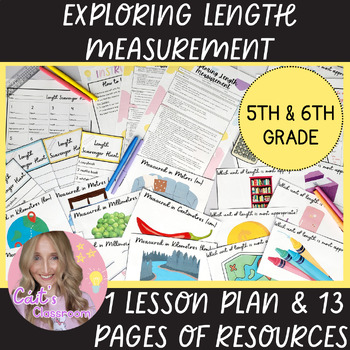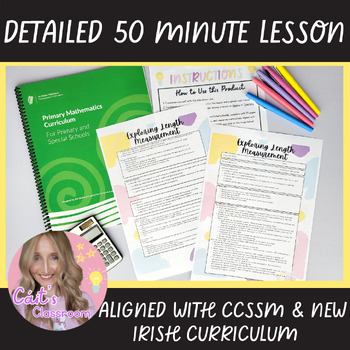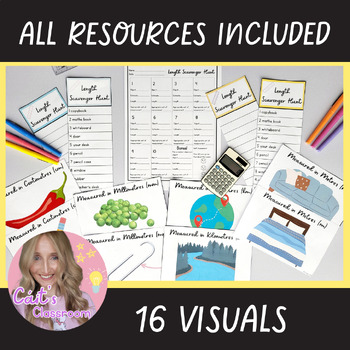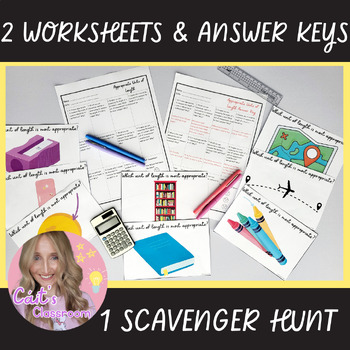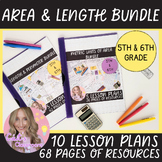Length Measurement Lesson Plan│Worksheets, Activities, Visual Aids│5th/6th Grade
- PDF
Also included in
- 5 lesson plans & 42 pages of activities/resources on metric units of length measurement and perimeter for fifth and sixth grade. Revolutionize your math classes with this comprehensive resource covering topics such as:Selecting, Estimating, Comparing and Measuring Metric Units of LengthMetric SyPrice $16.84Original Price $23.35Save $6.51
- 10 lesson plans & 68 pages of activities/resources on area, perimeter and length for fifth and sixth class.Revolutionize your math classes with this comprehensive resource covering topics such as:Measuring, calculating, and converting square metres to square centimetres.Calculating, converting,Price $26.40Original Price $40.53Save $14.13
Description
Searching for an engaging lesson for fifth/sixth grade on measuring length in metric units? Want it to include worksheets, activities and visual aids? Then this resource is for YOU!
Take the stress out of creating complete lesson plans and resources! This lesson includes hands-on estimation and measurement activities and individual practice worksheets featuring real-life scenarios.
This resource is also aligned with both CCSSM and the Irish Primary Mathematics Curriculum (2023) for seamless integration into planning documents.
Say goodbye to weekends planning on your laptop and hello to an engaged classroom – grab your copy TODAY!
Benefits:
- Saves teachers time and effort by clearly outlining how the lesson ties to new curriculum elements and competencies.
- Offers a complete, print-and-go resource with step-by-step instructions, ideal for newly qualified teachers who want support teaching maths to the senior classes.
- Enhances student understanding of selecting appropriate metric units of length for accurate communication and problem-solving.
In Depth Description:
This 50-minute lesson plan includes:
- 1 Measurement Scavenger Hunt list and worksheet (list template also provided).
- 8 Visual aids for comparing and contrasting metric units (kilometres, metres, centimetres, and millimetres).
- 8 Visual aids for selecting, justifying, and estimating lengths using appropriate metric units.
- 2 engaging worksheets—one focusing on estimating and measuring classroom objects with appropriate units, and another on selecting and justifying units in real-world contexts.
- 1 worksheet on selecting and justifying appropriate metric units of length in real-world contexts.
- 2 answer keys.
- Explicit links to the new Irish Primary Mathematics Curriculum (2023), specifically the element of reasoning and the competencies of being mathematical and being a communicator and using language.
- Explicit links with CCSSM.
Mathematical Practice Standards:
- MP2: Reason abstractly and quantitatively.
- MP3: Construct viable arguments and critique the reasoning of others.
5th Grade:
- CCSS.Math.Content.5.MD.A.1
6th Grade:
- CCSS.Math.Content.6.RP.A.3.d
Don't let this opportunity slip away! Elevate your teaching experience and engage your students - secure your complete lesson plan and resources TODAY!
Click here to join the Cáit's Classroom mailing list for valuable tips, tricks, and special offers designed to support newly qualified teachers in effectively teaching maths to 3rd-6th class students.
Related Products
⭐ Length Operations Math Lesson Plan│Worksheets & Game│Metric System│5th/6th Grade
⭐ Renaming Length Math Lesson Plan│Worksheets, Game, Guided Practice│5th/6th Grade
⭐ Perimeter Math Lesson Plan│Scale Drawing Perimeter Worksheet│5th/6th Grade
⭐ 2D Perimeter Math Lesson Plan│Worksheet & Hands-on Activities│5th/6th Grade

